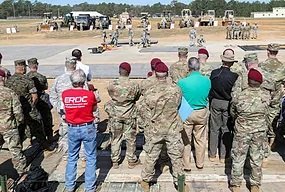

Military Members execute their operational missions and exercises (actual and training events respectively) using Tactics, Techniques, and Procedures, or TTP.
So do Project Managers!
It follows then that military Members, Veterans, and Retirees (“Veterans”) are project managers then!
Let’s explore how.
First, we’ll look at TTP, which “specify the ‘Who’, ‘What’, ‘Where’, ‘When’, and ‘How’ of warfighting” (Soldier’s Toolbox for Developing Tactics, Techniques, and Procedures (TTP), February 2010), i.e. execution of missions and exercises at the operational “doing” level.
Tactics are basically means (i.e. tools) to accomplish an end. Techniques are the ways a person uses his or her special knowledge or skills to accomplish an end. Procedures represent accepted ways of doing something. (Thanks to Ryan Stillions for his great piece on ‘civilianized’ TTP!)
Second, now we’ll look at the scale of ‘doing business’: strategy, tactical, and operational. Strategic represents planning and resourcing at the executive, long-term level; tactical represents the allocation and management or resources by managers at the mid to short-term level; and operational represents the application of resources and daily direction of planned execution towards the identified strategic and tactical objectives.
Third, we’ll discuss the relationship between missions, exercises, and projects. It’s the definition!
That’s because the formal, codified definition of a project is any “temporary endeavor undertaken to create a unique product, service, or result” (PMBOK® Guide, PMI, 2013). That means unconventional work that has a start and stop date (i.e. it’s temporary) and a unique outcome, a business reason in industry and a ‘Commander’s Intent’ in defense, is a project. Missions and exercises are projects, and vice versa!
Fourth, just like with any ‘job’ in the military, project management has a ‘field manual’, i.e. a technical how-to book. It’s colloquially known as the PMBOK® Guide. This codification of the profession’s lexicon, universal standard, and good practices rests on Table 3-1, a map depicting all of the processes, process groups, and knowledge areas described in the PMBOK® Guide. Project Managers, Project Teams, and Project Stakeholders collaboratively iterate through these 47 processes using Tactics, Techniques, and Procedures; TTP!
The premise of this article is that a vast majority of military Members, Veterans, and Retirees have significant amounts project management experience. How? Simply by doing their operational jobs! Which are really just strings of multiple projects across their career. When they plan, resource, lead, and debrief missions and exercises, they are managing projects!
The trick is translating this military experience into commercially viable, highly valuable project management experience instantly recognizable by recruiters and hiring managers in the CIVDIV (my affectionate term for the civilian workforce ;).
I help Veterans do this every week in a live, free, interactive Webinar. We provide you with the TTP to do it! You can register at www.vets2pm.com for the weekly Webinar convenient to you. I’ll see you soon Brothers and Sisters!
Cheers!
EAW
———————————————————————————————————-
Eric is a decorated two-Service, two-Era US Military Veteran; Serial Founder; experienced, credentialed project manager and PMI Chapter-recognized mentor; and an entertaining instructor/public speaker on project management, deep learning and the military transition, PMI’s PMP® and CAPM® exams, Vetrepreneurship; and project manager development. He helps Military Veterans change their lives profoundly through project management, entrepreneurship, and AI through inspiration, translation, training, and placement. For more information, please visit https://vets2pm.com, www.militaryvetstone.com, and www.linkedin.com/in/docwright2012.
———————————————————————————————————-
PMBOK® Guide, PMP, and CAPM are registered marks of the Project Management Institute, Inc.